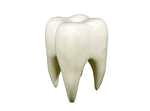
The visible part of a tooth, otherwise known as the crown, is only a small portion of the living system. The crown is made up of enamel, the hardest substance found within the body. It is bone that has been enriched with large percentages of calcium. That's why people who drink lots of milk or take calcium supplements have strong bones and teeth. The enamel is thickest at the crown, and thinnest near the roots of the teeth. The permanent teeth are the second set of teeth that will last the rest of your life. They tend to be more yellow (and not just because of coffee) and are extremely hard. The final set of teeth is made up of 32 teeth, or 16 on each jaw. There are two central incisors for biting, two lateral incisors for biting, two canines for tearing and cutting, four premolars for chewing, and six molars for chewing. Your teeth are by far one of the most important things you use every day. Many people end up neglecting their teeth with improper oral hygiene. You should take care of them by brushing at least twice a day, flossing once per day, and going for regular dental checkups at least twice per year.
For individuals who have chipped, cracked or irregularly shaped teeth, dental contouring and reshaping can be just the ticket for a more beautiful smile. With a little dental contouring, you can make a huge difference in the way you feel about your smile. Good cosmetic dentistry can give you a smile that is the envy of others. Tooth contouring by a cosmetic dentist does require that you have normal, healthy teeth. Tooth reshaping, or tooth sculpting, is a safe and conservative way to improve your smile. Teeth may become weaker if large amounts of enamel are removed, tooth reshaping should be limited to minor changes or combined with veneers or bonding for the best smile.
This section of our cosmetic dentistry information site provides you with some background into dental veneers, both composite veneers and porcelain veneers. Dental veneers, sometimes called tooth veneers, can be used to correct both color and shape problems. Dental veneers (sometimes called porcelain veneers or dental porcelain laminates) are wafer-thin, custom-made shells of tooth-colored materials designed to cover the front surface of teeth. These shells are bonded to the front of the teeth changing their color, shape, size or length and resulting in an improved appearance. Dental veneers can be made from porcelain or from resin composite materials. Porcelain veneers resist stains better than resin veneers and better mimic the light reflecting properties of natural teeth. Resin veneers are thinner and require removal of less of the tooth surface before placement. You will need to discuss the best choice of veneer material for you with your dentist. Veneers, porcelain or plastic, are placed over the front teeth to change color shape of the teeth. Veneers are ideal for teeth that are too small, too big, or have uneven surfaces. It is very common for people to have imperfect teeth, either oddly shaped teeth, chipped teeth, crooked teeth, teeth with small holes in them, or an inappropriate sized tooth or teeth that have an odd appearance. Veneers solve such irregularities and create a durable and pleasing smile.
Teeth whitening can be accomplished many different ways. Considered a cosmetic procedure, teeth whitening has become very popular in recent years with the development of various methods that range from drugstore products to dental visits. For individuals who are looking for a fast way to achieve dramatic teeth whitening results, in-office whitening is the way to go. Protective gel is applied to the gums, lips and other tissue around the teeth, and then a bleaching solution is applied to the tooth enamel. A high intensity laser or other type of light catalyzes the bleach, and the teeth are treated for one to two hours. Mild side effects are to be expected with any teeth whitening procedure, and may range from slight discomfort to sensitivity to hot and cold. While serious side effects are extremely rare, any extended sensations of pain should immediately be reported to a dentist. Irritation to the gums and mouth tissues should also be watched for and reported if persistent.
In areas of your mouth that are under less stress, such as your front teeth, a cantilever bridge may be used. Cantilever bridges are used when there are teeth on only one side of the open space. Bridges can reduce your risk of gum disease, help correct some bite issues and even improve your speech. Bridges require your commitment to serious oral hygiene, but will last as many ten years or more. If you a space from a missing tooth, a bridge will be custom made to fill in the space with a false tooth. The false tooth is attached by the bridge to the two other teeth around the space - bridging them together. Your cosmetic dentist may have you use a Flipper appliance. A Flipper is a false tooth to temporarily take the place of a missing tooth before the permanent bridge is placed. A Flipper can be attached via either a wire or a plastic piece that fits in the roof of your mouth. Flippers are meant to be a temporary solution while awaiting the permanent bridge.
There are two main types of dentures. Both Complete Dentures and Partial Dentures are finely crafted, custom-fitted. If you properly maintain your dentures they will appear natural and provide a perfect smile. Additionally, dentures help strengthen muscles controlling your expressions that require the support of your teeth, rid you of pronunciation problems caused by missing teeth and aid with chewing. If you've lost, or are losing, all of your teeth a Complete Denture is something to discuss with your cosmetic dentist. If some of your teeth remain and are healthy, a partial denture may be your way to a great smile. The setting up dentures procedure begins with a wax bite impression of your mouth that will give your dentist exacting measurements. A try-on appointment will fine tunes color, shape, and custom-fit. After your final dentures are fabricated, they will be placed and informed of their required care.

Definition interpretationDental fillings
- Dental fillings are inserted as restorations in the treatment of dental cavities, after drilling out the cavities.
Dental implants
- Dental implants are surgically fixed substitutes for roots of missing teeth. Embedded in the jawbone, they act as anchors for a replacement tooth, also known as a crown, or a full set of replacement teeth.
Dentures
- Removable complete dentures are full-mouth false teeth, which are used when a patient has no teeth left on either the mandibular arch, the maxillary arch, or both.
Veneer
- A layer of tooth-colored material, usually porcelain or acrylic resin, attached to and covering the surface of a metal crown or natural tooth structure.
Anesthesia
- Total or partial loss of sensation, especially tactile sensibility, induced by disease, injury, acupuncture, or an anesthetic, such as chloroform or nitrous oxide.
- Local or general insensibility to pain with or without the loss of consciousness, induced by an anesthetic.
- A drug, administered for medical or surgical purposes, that induces partial or total loss of sensation and may be topical, local, regional, or general, depending on the method of administration and area of the body affected.
Bridge
- A dental bridge is a prosthesis used in place of missing teeth and may be removable or permanently attached.
Dental cavities
- The formation of cavities in the teeth by the action of bacteria; tooth decay.
- Also known colloquially as tooth decay.
Dental crown
- Full-coverage restoration (sometimes incorrectly called a cap) is a prosthetic tooth designed by a dentist and usually created by a lab technician.
Porcelain
- A hard, white, translucent ceramic made by firing a pure clay and then glazing it with variously colored fusible materials.
Stomatology
- The medical study of the mouth and its diseases.
Tooth bleaching
- Also known as tooth whitening.
|